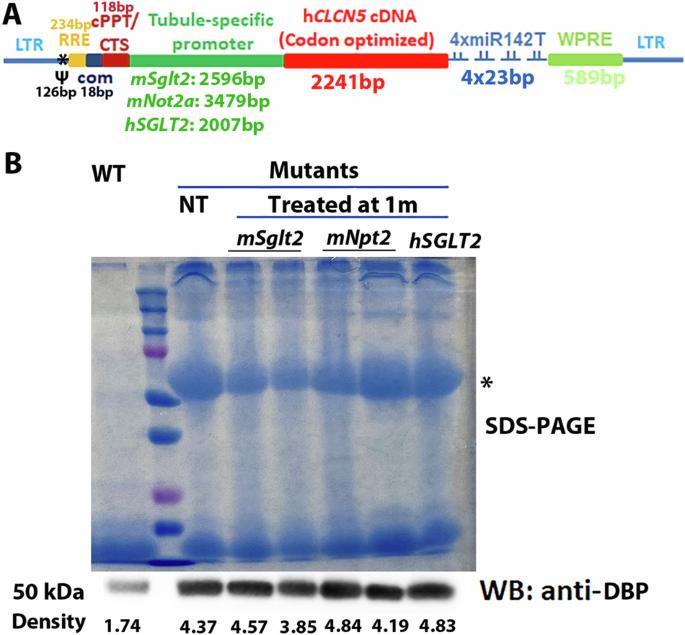Gene therapy of Dent disease type 1 in newborn ClC-5 null mice for sustained transgene expression and gene therapy effects
IF 4.5
3区 医学
Q1 BIOCHEMISTRY & MOLECULAR BIOLOGY
引用次数: 0
Abstract
Dent disease type 1 is caused by changes in the chloride voltage-gated channel 5 (CLCN5) gene on chromosome X, resulting in the lack or dysfunction of chloride channel ClC-5. Individuals affected by Dent disease type 1 show proteinuria and hypercalciuria. Previously we found that lentiviral vector-mediated hCLCN5 cDNA supplementary therapy in ClC-5 null mice was effective only for three months following gene delivery, and the therapeutic effects disappeared four months after treatment, most likely due to immune responses to the ClC-5 proteins expressed in the treated cells. Here we tried two strategies to reduce possible immune responses: 1) confining the expression of ClC-5 expression to the tubular cells with tubule-specific Npt2a and Sglt2 promoters, and 2) performing gene therapy in newborn mutant mice whose immune system has not fully developed. We found that although Npt2a and Sglt2 promoters successfully drove ClC-5 expression in the kidneys of the mutant mice, the treatment did not ameliorate the phenotypes. However, gene delivery to the kidneys of newborn Clcn5 mutant mice enabled long-term transgene expression and phenotype improvement. Our data suggest that performing gene therapy on Dent disease affected subjects soon after birth could be a promising strategy to attenuate immune responses in Dent disease type 1 gene therapy.

对新生 ClC-5 基因无效小鼠进行 1 型 Dent 病基因治疗,以获得持续的转基因表达和基因治疗效果。
Dent 病 1 型是由于 X 染色体上的氯化物电压门控通道 5(CLCN5)基因发生变化,导致氯化物通道 ClC-5 缺乏或功能障碍而引起的。Dent 病 1 型患者会出现蛋白尿和高钙尿症。之前我们发现,慢病毒载体介导的 hCLCN5 cDNA 补充疗法对 ClC-5 基因缺失小鼠的治疗仅在基因递送后的三个月内有效,治疗效果在四个月后消失,这很可能是由于对治疗细胞中表达的 ClC-5 蛋白的免疫反应所致。在此,我们尝试了两种策略来减少可能的免疫反应:1)使用肾小管特异性 Npt2a 和 Sglt2 启动子将 ClC-5 的表达限制在肾小管细胞中;2)在免疫系统尚未发育完全的新生突变小鼠中进行基因治疗。我们发现,虽然 Npt2a 和 Sglt2 启动子成功地驱动了突变小鼠肾脏中 ClC-5 的表达,但治疗并未改善其表型。然而,向新生Clcn5突变小鼠的肾脏输送基因可实现长期转基因表达并改善表型。我们的数据表明,对出生后不久就受登特病影响的受试者进行基因治疗,可能是在登特病 1 型基因治疗中减轻免疫反应的一种有前途的策略。
本文章由计算机程序翻译,如有差异,请以英文原文为准。
求助全文
约1分钟内获得全文
求助全文
来源期刊

Gene Therapy
医学-生化与分子生物学
CiteScore
9.70
自引率
2.00%
发文量
67
审稿时长
4-8 weeks
期刊介绍:
Gene Therapy covers both the research and clinical applications of novel therapeutic techniques based on a genetic component. Over the last few decades, significant advances in technologies ranging from identifying novel genetic targets that cause disease through to clinical studies, which show therapeutic benefit, have elevated this multidisciplinary field to the forefront of modern medicine.
 求助内容:
求助内容: 应助结果提醒方式:
应助结果提醒方式:


